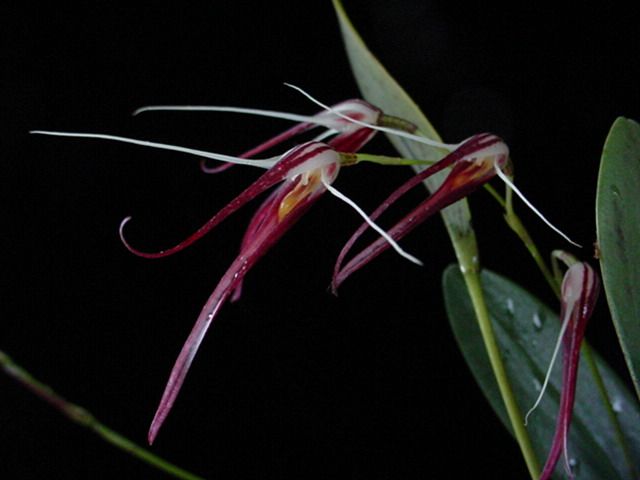

Pleurothallis sirene Rchb.f. 1855 SUBGENUS Restrepioidia Luer 1986
Photo by © Gerardo Torres
Drawing by © Fitch and the Curtis Botanical Magazine
Drawing by Carl Luer




Common Name or Meaning The Siren Pleurothallis [Greek Mythological nymph in the form of birds]
Flower Size 2" [5 cm]
Found in northeastern Colombia and northwestern Venezuela at elevations of 2000 to 2400 meters as a small to medium sized, cold growing, repent to caespitose epiphyte with smooth, stout, erect ramicauls enveloped by a tubular sheath below the middle and 1 to 2 shorter ones at the base and carrying a single, apical, erect, coricaeous, elliptical, subacute to obtuse, cuneate below into the subsessile base leaf that blooms in the summer and fall on a loose, arising through a reclining spathe at the base of the leaf, subsecund, 4 to 8" [10 to 20 cm] long, simultaneously few to several flowered inflorescence with thin, tubular, shorter than the pedicel floral bracts.
Similar to P glossopogon and often cited as a synonym but differs in the anterior lobe of the lip which is slender, acute and only minutely denticulate while in P glossopogon the anterior lobe is thickened and markedly fimbriate-papillose.
Synonyms Humboldtia sirene (Rchb.f.) Kuntze 1891; Lindleyalis sirene (Rchb.f.) Luer 2004; Pleurothallis scapha Rchb.f. 1874;
References W3 Tropicos, Kew Monocot list , IPNI ;
* Bonplandia (Hannover) 3: 71 Rchb.f 1855;
Die Orchideen Schlechter 1915 as P scapha;
Orchids of Venezuela [An illustrated field guide] Vol. 3 Ramiro and Carnevali 2000 hmm I think it is P glossopogon;
Icones Pleurothallidinarum Vol XXVI Pleurothallis subgenus Acianthera and Three Allied subgenera, A Second Century of new Species of Stelis of Ecuador, Epibator, Ophidion and Zootrophion Luer 2004 as Lindleyallis sirene
--------------------------------------------------------------------------------------------------------------------------
-------------------------------------------------------------------------------------------------------------------------